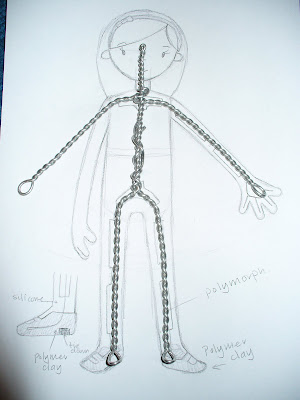To make the head for Alice I started with a ball of tin foil, this reduces the amount of polymer clay I'd use and makes the head lighter so that the model won't be too top heavy. To make the foil ball as compact as possible I rolled it on the cutting mat, putting all of my weight on it and made it a little smaller than the size I wanted the head to be to account for the layers of polymer clay...

Next I added a layer of polymer clay to the foil ball. It proved to be quite difficult to shape the clay as whilst shaping one side i'd squish the side that I was holding, so I covered it with a thin layer, just as a starting point and dried it out in the oven...
Once that had cooled (and it looked a bit like an egg) I started adding shaping and detail bit by bit, and baking it after each addition. First I added to the side of the face to widen it and create the shape I wanted, then baked it. Once that had cooled I added more clay to the chin to make it a little more pointed, and added the ears by rolling a ball, flattening it and then cutting it in half and sticking it to the sides of the head and blending the edges in, then I used the sharp end of my modeling tool to add detail, giving the ear more shape...
The size of the head was including the thickness of the layer of hair, so I didn't want to add too much more clay when creating the hair shape. I added clay to the back of the head to make it more rounded for when I covered it with the hair. For the fringe I rolled two long thin pieces of clay and placed them where I wanted the edge of the fringe to be, then blended the inside edge in...
Next, i added a very thin layer of clay next to the first part of the fringe, and blended it up and into the shape of the head, then, once again baked it all...
All this adding-a-bit-and-baking-it-malarkey was very time consuming, but the last time I used super sculpey I managed to burn it very easily, so as well as this method making it easier for me to mould, it meant I was able to dry out very thin sections at a time and keep a close eye on it, ensuring that I didn't burn it! though this did mean I was actually sitting in front of the oven, setting the timer for a minute at a time!
This image shows the head from the side where I have rounded out the back of the head...
This morning I removed the temporary eyes and added neater ones and then baked this in the oven. the mouth and brows will be added in Photoshop once it has been photographed.
The next step is to give it a little sand, just to tidy up any messy areas where I've been blending, like in front of the ears, which you can see on the photo above, just to give it a smoother finish, then it can be painted and the rosy cheeks added, then i'll start gluing the hair on.



















































